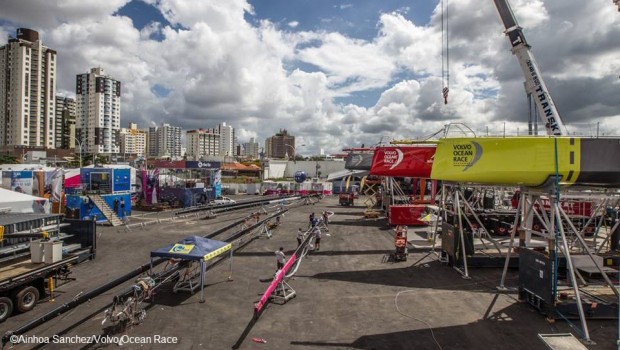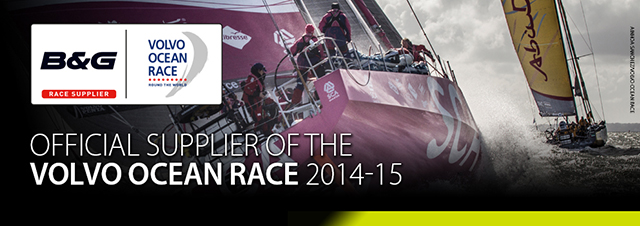Volvo Ocean Race: Northbound to Newport
Published on April 14th, 2015
Now that the Volvo Ocean Race has crossed the Southern Ocean and is back into the Atlantic, the teams will unwind their Leg 1 passage across the equator and return to the northern hemisphere. Starting on April 19, Leg 6 runs from Itajai, Brazil to Newport in Rhode Island, USA. It’s 5,010 miles and it will run the full range of climate zones. Courtesy of race supplier B&G, Mark Chisnell provides a preview of what the teams (and fans) should expect…
Crossing Climate Zones
The race from Auckland to Cape Horn was distinguished by the fact that it all took place in a single climate zone, racing east with the low pressure systems that circle the Antarctic.
Now we’re back to racing south to north, and the fleet will be back to crossing climate zones; passing through a pattern that we should all be able to recite by heart by now – South Atlantic High, south-east trade winds, Doldrums, north-east trades, Azores High and then the westerly’s of the North Atlantic.
It’s been a theme of this blog that each of these climate zone transitions creates a passing lane. There are much bigger opportunities for gains or loses compared to sailing with or against the weather systems in a single climate zone. Fortunately for all those tired navigators and skippers, this particular leg is familiar stuff – apart from the fact that we came most of this way in Leg 1 – the Volvo Ocean Race has raced from Brazil to New England on several previous occasions.
High Problem
We’re starting from Itajai on Sunday, and although that’s five days out (I’m writing this on Tuesday), it’s worth a look at the forecast. The prediction is for the South Atlantic High to be centred on roughly the same latitude as the start, about two thirds of the way across to Cape Town. It will generate a light-ish north to north-easterly headwind for the first section of the race, up towards Rio. There is a small low pressure forecast to form off Itajai on Monday/Tuesday night, and this could mean that they are soon beating into a freshening breeze.
In theory, the trade winds should be established not too far north of Rio, and it looks like this will be the case. Once they get around the corner and head for the eastern tip of Brazil at Recife they should transition into weak, east or south-easterly trade wind conditions. It’s important not to forget the south-running Brazil Current, which runs all the way down the coast from Recife to Buenos Aires – the navigators will be watching the current charts to find the swirls and back eddies that can help.
Cutting the Corner…Or Not
The next strategic problem is how close to cut the corner of Brazil at Recife. Two things have to be balanced – the further offshore they sail, the stronger and steadier the breeze ought to be, but the more miles they have to travel. There’s an old rule of thumb for this one – stay within 10 miles of the coast, or stand further off than 100 miles.
There’s a chance for a big gain here, Lawrie Smith took the ‘within 10 miles’ bit very seriously in 1997-98, slipped around the corner within smelling distance of the beach and powered into a comfortable lead. Bouwe Bekking did the same thing in 2005-06 – and might be wondering if he will get the chance for a replay this time around.
Cloud Roulette
Next up will be the fourth and final encounter with the Doldrums. This particular crossing should be relatively straightforward, as the fleet will already be lined up to transit the Doldrums at what is usually the narrowest point. However, there will be the usual game of cloud roulette to be played before they all escape for the last time. Someone will get nailed, they always do.
Champagne Sailing
The first boat clear of the Doldrums should reap the usual reward of some steady, fast sailing in the north-east trade winds. It’s at this point that we will hit the influence of another name familiar from Leg 1, the Azores High. Its position will determine the strength and extent of the trade winds. The strategy will be to ride the trades north and then skirt the western edge of the High – but it can move a long way west and is known in the States as the Bermuda High. If the centre is closer to the latter than the former, then dodging light air may become an issue.
A Home Straight with Potholes
The final section is potentially the most complex. The fleet will be heading north-west away from the influence of the Azores High and into the path of the low pressure systems spinning off the North American continent and heading for Europe. The behaviour of these systems will be critical in the approach to Newport. And given that we’re still not far from the spring equinox – traditionally an unstable time of year – there’s every chance of the fleet meeting some energetic weather.
If that wasn’t enough, the navigators will simultaneously have to negotiate the influence of the Gulf Stream. This runs north-east all the way up the eastern seaboard of the US, before turning right and heading east across the Atlantic to warm the shores of Northern Europe. Crossing this swirl of north-east flowing warm water and eddies while dealing with the low pressure systems will challenge everyone. Going upwind in the Gulf Stream can be brutal and is to be avoided if possible.
Other Thoughts
Abu Dhabi Ocean Racing’s skipper, Ian Walker has told us that the team’s overall race strategy was to minimise risk until they were around Cape Horn and back in the Atlantic – then they would see where they stood. So now we’re back in the Atlantic, and after the unfortunate dismasting of Dongfeng Race Team, Walker and his crew are in very good shape. They hold a seven point lead from the French-Chinese team, a big buffer given the consistency of the leaders.
The bulk of the rest of the fleet is grouped tight behind Dongfeng, and I suspect that the latter will be more worried about getting caught than trying to close what is now a big gap to first. It does look like it’s Walker’s to lose from here; if Abu Dhabi keep sailing the way they have for the final four legs, no one can catch them. Of course, they will also know that they are just one major breakdown from being right back with the pack.
I’m looking forward to this one, we should get a really good mix of conditions on this leg, and with all those climate zone transitions and changing weather it ought to be a really good test for the fleet. And when they get to Newport, they should be assured of a warm American welcome from one of the US’s most famous sailing towns. See you back here next Tuesday to check up on the opening moves.
Race website – Tracking – Scoreboard – Videos – Route
Background: The 2014-15 Volvo Ocean Race began in Alicante, Spain on Oct. 11 with the final finish on June 27 in Gothenburg, Sweden. Racing the new one design Volvo Ocean 65, seven teams will be scoring points in 9 offshore legs to determine the overall Volvo Ocean Race winner. Additionally, the teams will compete in 10 In-Port races at each stopover for a separate competition – the Volvo Ocean Race In-Port Series. The sixth leg, from Itajaí, Brazil to Newport, USA (5,010 nm), begins April 19 with an ETA of May 6.
Make sure you sign up for the newsletter to ensure that you receive all of B&G’s Volvo Ocean Race news as it happens at B&G’s dedicated Volvo Ocean Race Blog.
For your chance to win big with B&G during the Volvo Ocean Race 2014-2015, keep an eye on the B&G website and official Facebook page.










 We’ll keep your information safe.
We’ll keep your information safe.